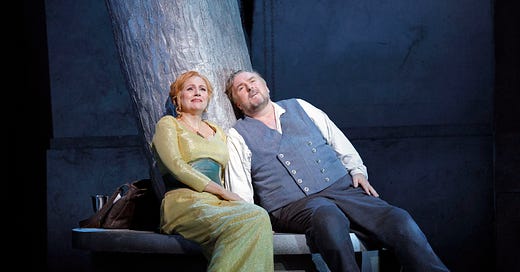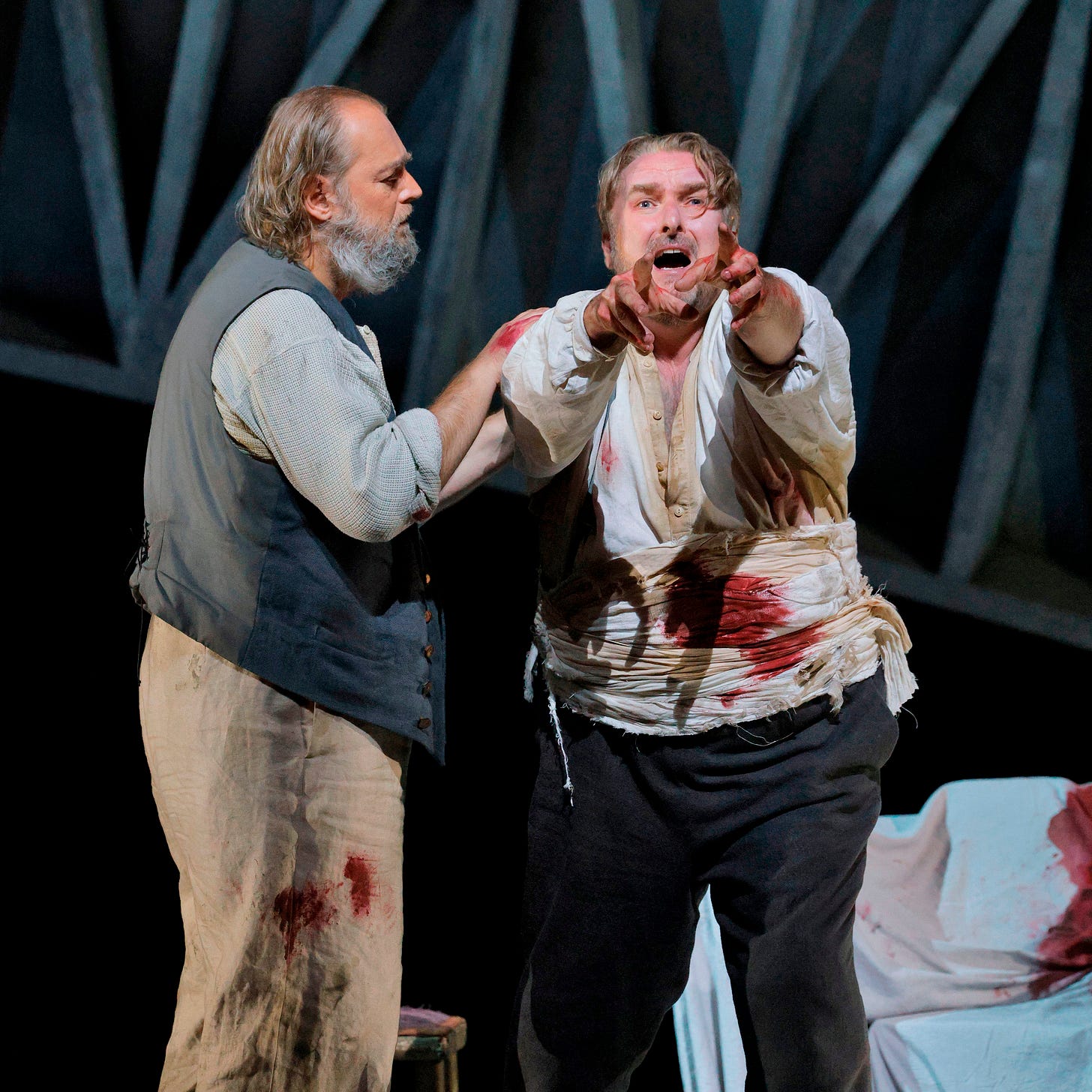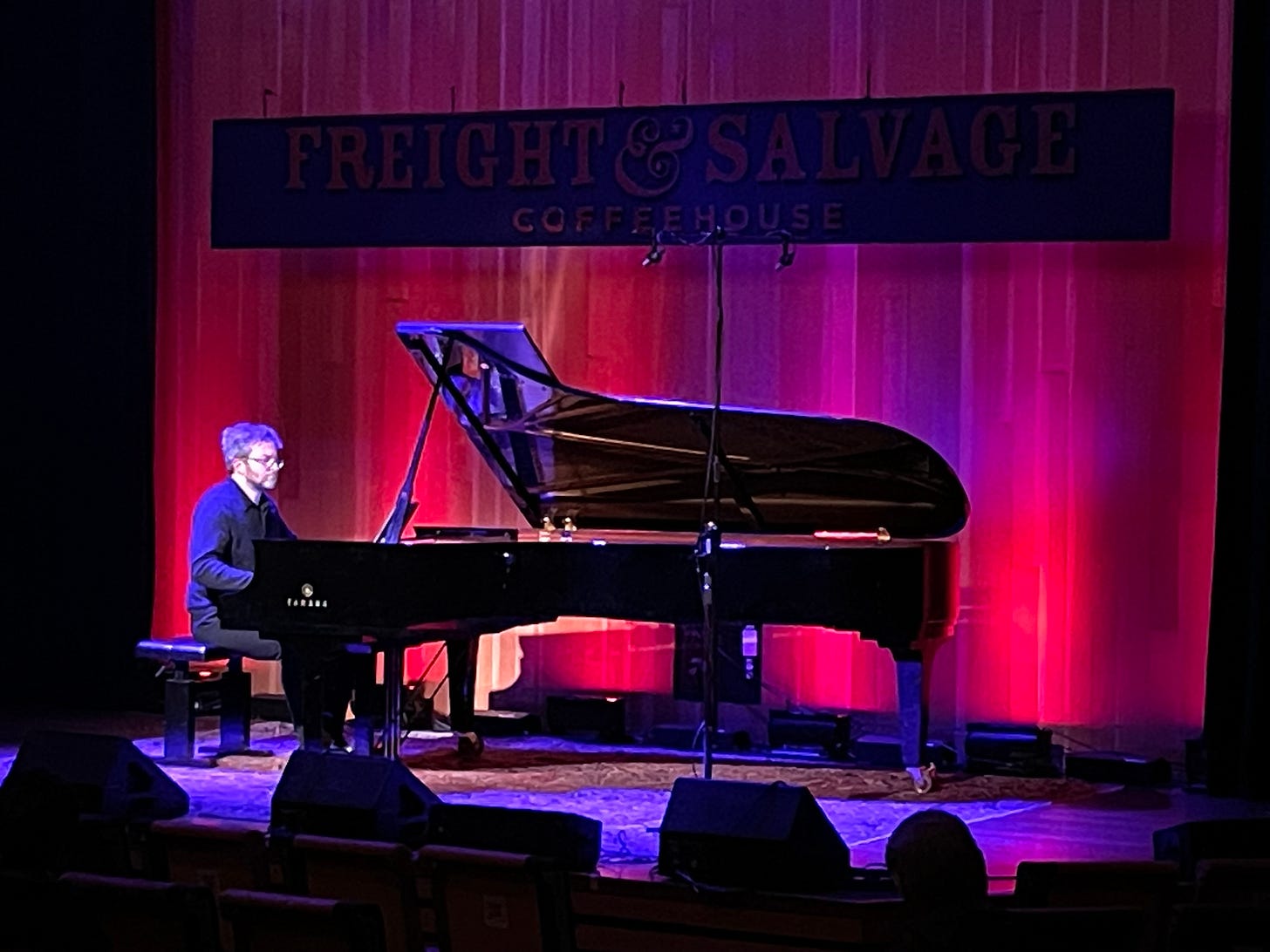Trysting with Tristan
The San Francisco Opera’s latest Wagnerian production, with music director Eun Sun Kim at the helm, is a triumph
One of the things music critics get asked a lot is, “Do you absolutely have to review opening night?” I understand the concern. Especially in the world of opera, the opening performance is the one where nerves are high and glitches happen. Performers often say, “You should have come for the closing, we had it all ironed out by then.” But of course music criticism is journalism, and you can’t really wait around once the curtain goes up.
There's another reason, too. Because of a confluence of personal and theatrical conflicts, I wasn’t able to get to the opening performance of Tristan and Isolde at the San Francisco Opera on Oct. 19, or the second performance either. And now here I am, jumping up and down and trying to grab you by the lapels to tell you that you must see this production, and there are only two performances left in the run. That’s not right.
Please don’t allow this one to pass you by, though. It’s the finest Tristan I’ve ever encountered at the War Memorial Opera House* — powerfully cast from top to bottom, conducted by music director Eun Sun Kim with a fascinating blend of tenderness and urgency, and graced with the magical presence of the S.F. Opera Orchestra throughout the long 4½-hour span over which Wagner’s tale spins out. It’s a production that makes time stand still, but in a good way; nothing really happens in this opera, and the trick is to make the listener believe otherwise. Kim, the cast, and the orchestra pull it off with elegance and grace.
I was less taken with director Paul Curran’s theatrically static stagecraft, and Robert Innes Hopkins’ boxy designs did nothing to weaken my fond memories of the fluid, vividly colored David Hockney production that was used here last time (and at the Los Angeles Opera before that). Yet at the final curtain on Sunday afternoon, I rose from my seat with the conviction that I’d witnessed something unique and rare.
In the title roles, tenor Simon O’Neill and soprano Anja Kampe brought vocal brilliance and shapeliness to their assignments again and again. O’Neill’s most recent local appearance was as a heroic Lohengrin just a year ago, and his return found him in even more vibrant voice — proudly noble in Act 1, meltingly sweet in the vast love duet of Act 2, and astonishingly vigorous in the pain-laden solo marathon of Act 3. Kampe has been absent from San Francisco since her potent company debut as Sieglinde in 2011, which is far too long for a singer of such eloquence and range.
And because every Wagnerian cast for the foreseeable future amounts to a scouting report for the future Ring production we’ve been promised, it’s worth taking note of two formidable company debuts, by German mezzo-soprano Annika Schlicht as a mesmerizing Brangäne and Austrian baritone Wolfgang Koch as a doughty, muscular Kurwenal. Bass Kwangchul Youn was a woolly but emotionally poignant King Marke.
The really interesting part was Kim’s conducting, with a gift for nuance that grew on me over the course of the afternoon. I’m sure I’m not the only San Francisco operagoer for whom Donald Runnicles, the company’s former longtime music director, is a fixed reference point in the Wagner/Strauss repertoire. His sweeping command and his mastery of broad musical vistas — heard most recently in last year’s Die Frau ohne Schatten — are always thrilling, but they’re far from the only possible approach to this music. Kim works with a gentler, more shaded expressive palette, allowing emotion to surface from within rather than imposing it from without. The results can sneak up on you and tear your heart out.
If I may borrow a beat from Brangäne: Drop what you’re doing and move. Time is running short.
*This is indeed the finest Tristan I’ve heard at the San Francisco Opera, but that statement requires a little context. For one thing, it’s the only good Tristan I’ve heard from the company. The last one, in 2006, had some virtues but was weakly cast in the title roles; the one before that, in 1998, was a memorable debacle. I don’t recall the 1991 production, which I certainly heard, but the Isolde was Gabriele Schnaut, so you do the math. (Nothing but respect for William Johns, the Tristan.) It was between 1970 and 1980, before I arrived in the Bay Area, that the piece was cast with the likes of Birgit Nilsson, Gwyneth Jones, Wolfgang Windgassen, and Jess Thomas. Golden days of yore!
Tristan and Isolde: San Francisco Opera, through Nov. 5. www.sfopera.com.
Elsewhere:
Lisa Hirsch, San Francisco Chronicle/SFCV: “it’s rare to experience a performance in which all of the elements come together so brilliantly.”
Thomas May, Gramophone: “SFO’s new Tristan und Isolde is generating a wave of euphoria…”
Charles Lewis III, 48 Hills: “this entire season has been primarily defined by the personal touch [Kim has] brought to their productions…and this one is no different.”
Gabe Meline, KQED: “If you’ve never spent five hours at the opera for a story that would ordinarily take three minutes to tell, are you even living?” 😆
Stephen Smoliar, The Rehearsal Studio: “this was an account of Wagner’s commitment to ‘opera as drama’ that would have done the master proud.”
Russian doll
Another thing music critics get asked a lot is, “What’s the point of reviewing an event once it’s over and nobody can hear it?” That one’s easier to answer, because there’s a lot of potentially interesting information, even in a writeup of a one-off event. Take, for example, Monday night’s tremendous recital by the American pianist Conor Hanick of music by the late Russian (or Soviet?) composer Galina Ustvolskaya, presented by Other Minds at the Freight & Salvage in Berkeley. Anyone who was there already knows how revelatory it was. Anyone who wasn’t present will take my word for it, I hope, but also store away these tidbits for future use:
• Ustvolskaya, who died in 2006 at 87, was a ferociously original and compelling artist, and her music could use a champion to help it into the performance mainstream.
• Hanick, whom local audiences recently heard as the soloist in Samuel Adams’ beautiful piano concerto No Such Spring and again a month ago in Messiaen’s Harawi, is just such a champion.
• Other Minds, now approaching its 30th year, remains one of the Bay Area’s most indispensable purveyors of musical adventure.
The recital consisted of Ustvolskaya’s six Piano Sonatas, a stretch of about an hour’s worth of music composed between 1947 and 1988. It’s not accurate to say that the music is unlike anything you’ve heard — Bach’s example is everywhere, and the influence of Debussy, Cowell and even Shostakovich (Ustvolskaya’s teacher and sometime lover) can be detected now and again. But these pieces are ravishing in their starkness and unpredictability, and Hanick played them with almost demonic clarity.
Ustvolskaya’s formal thinking is wonderfully eclectic, ranging from taut little one-movement pieces to broad suite-like creations. But she has ingrained habits that a listener soon comes to recognize as old friends. One is the practice of beginning things with a single melodic line, like a fugue subject for which the actual fugue has been lost. Another is a lullaby-like three-note pattern that shows up in the left hand in sonata after sonata. The music is at once strident and inviting, brash and oddly coy. Until, that is, you get to the extraordinary Sixth Sonata, which bursts forth in a torrent of thunderous chords and fierce forearm clusters — smash! bang! — that doesn’t let up for an instant. It’s the most aggro, unchainable, and beautiful music I’ve heard in years.
Why are we here?

On Saturday night, Eun Sun Kim led the San Francisco Opera Orchestra and Chorus, along with a quartet of vocal soloists, in one performance of Beethoven’s Ninth Symphony at the War Memorial Opera House. When I teach music criticism, the single precept I have to repeat most often is to implore students not to begin a review that way. Such-and-such a concert took place on such-and-such a night and you were there? So what? Tell the reader what struck you as interesting about the event!
In this case, though, the fact that the concert took place was the curious incident in the night-time, as Sherlock Holmes might have said. Why was this event scheduled? What purpose did it serve? I’ve been wracking my brain about this since the day the company’s season was announced, and I’m no closer to an answer than I ever was. If it was to give Kim some exposure in non-operatic music, then why not something that’s less of a warhorse? Sure, she does great in Verdi and Wagner, but can she conduct Beethoven’s Ninth? said no one ever.
Here's the dark reverie to which I fell prey during the performance, which was perfectly fine but in no way noteworthy. Before 1980, when Davies Symphony Hall was built, the San Francisco Symphony gave its concerts in the War Memorial Opera House. I didn’t witness that period, but it’s always sounded pretty ghastly. In that vast, cavernous space, dimly lit as befits an opera, I imagine something out of a midcentury Hollywood depiction of an orchestral concert — Unfaithfully Yours, say. And sure enough, that was exactly the vibe the other night: stiff, gloomy, and archaic. I channeled my inner Kamala and thought, “We are not going back.” There are weird rumors circulating sotto voce about a possible merger between the Symphony and the Opera; if for no other reason, that better not happen.
Once the Beethoven was through, I dashed across MTT Way to catch the second half of the San Francisco Symphony’s program with guest conductor Thomas Wilkins. The selling point here was not the umpteenth rehash of familiar music by famous white guys Leonard Bernstein and George Gershwin, but rather Wood Notes, a lush and rich-hued four-movement orchestral suite from 1947 by the African American composer William Grant Still. It’s pretty irresistible, and Wilkins’ delicately etched performance was yet another in a long, long line of arguments about how much music we just don’t get to hear because, tautologically, it’s music we just don’t get to hear.
Elsewhere:
Steven Winn, San Francisco Chronicle/SFCV: “curiosity and anticipation were high for Kim’s first-ever performance of Beethoven’s Ninth…The results, unfortunately, fell considerably short of expectations.”
Rebecca Wishnia, San Francisco Chronicle/SFCV: “as [Wilkins] conducted an all-American program at Davies Symphony Hall on Friday, Oct. 25, he often wore a broad smile — even when the going got tough.”
Lisa Hirsch, Iron Tongue of Midnight: “William Grant Still's Wood Notes is half the works by Black composers [on the SFS season.]…Where on earth are Florence Price, George Lewis, George Walker, Tania Leon, Errolynn Wallen, Pamela Z, Carlos Simon, Julia Perry, Jessie Montgomery, Adolphus Hailstork, Eleanor Alberga, and so many more?”
Stephen Smoliar, The Rehearsal Studio: “by all rights, the Still offering should have been the high point of the evening, since it was an SFS debut. However, Wilkins seems to have had his head only in the notes without bringing much expressiveness to the four different evocations of woodland settings.”
Cryptic clue of the week
From Out of Left Field #239 by Henri Picciotto and me, sent to subscribers last Thursday:
Feature of Utah? It isn’t an island (6)
Last week’s clue:
Writers I have thoughtfully absorbed (7)
Solution: PENSIVE
Writers: PENS
I have: I’VE
thoughtfully absorbed: definition (as an adjective)
Coming Up
• California Symphony: What’s an orchestra anyway? It’s a collection of wildly different kinds of instruments all playing together in different combinations, a tangle of insane chaotic complexity that somehow produces magic. There’s a whole type of piece that amounts to composers Explaining It All For You, and Donato Cabrera leads the orchestra in two masterpieces of the genre: Britten’s Young Person’s Guide to the Orchestra and Mason Bates’ delightful Philharmonia Fantastique. Brahms’ Fourth Symphony lets you witness the results in action. Nov. 2-3, Lesher Center for the Arts, Walnut Creek. www.californiasymphony.org.
• Left Coast Chamber Ensemble: The chance to hear Schoenberg’s landmark song cycle Pierrot Lunaire is always tantalizing, but the opportunity to hear it sung by soprano Nikki Einfeld — one of the Bay Area’s most consistently daring and dynamic artists — makes this a must. Artistic director Matilda Hofman conducts a program that also includes music by Tomàs Peire-Serrate and Maria Schneider. Nov. 2, Noe Valley Ministry; Nov. 3, Berkeley Hillside Club. www.leftcoastensemble.org.
• Dover Quartet: Dvorák famously drew on the music of African American and Native American traditions during his sojourn in the U.S., doing so in a way that was at once deeply flawed (as any such exercise must be) and comparatively respectful. The Dover Quartet’s Berkeley program offers a canny blend of the composer’s “American” Quartet with the increasingly prominent music of the Chickasaw composer Jerod Impichchaachaaha' Tate, for what promises to be a lively cross-century musical discussion. Nov. 3, Hertz Hall, UC Berkeley. www.calperformances.org.







